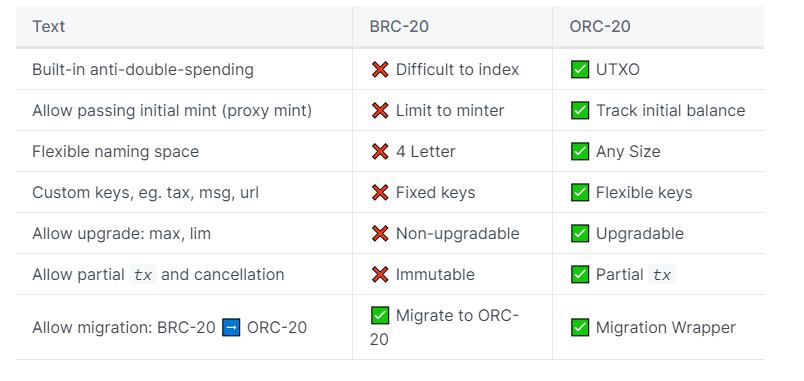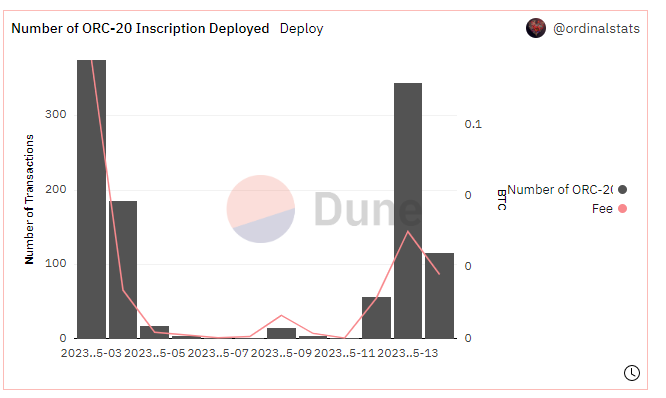Fiat-Währungen
Kryptowährungen
What is ORC-20 Tokens?
What is ORC-20?
ORC-20 is an open standard for ordinal token on Bitcoin network to enhance the features of BRC-20, a popular ordinals token standard. It is aimed to be backward compatible with BRC-20, to improve adaptability, scalability, and security, and to eliminate the possibility of double spending. However, ORC-20 is an experimental project and there is no guarantee that the tokens created with this standard will have any value or utility. Therefore, users should exercise caution and do their own research before using ORC-20.ORC-20 is an open standard for ordinal token on Bitcoin network to enhance the features of BRC-20, a popular ordinals token standard. It is aimed to be backward compatible with BRC-20, to improve adaptability, scalability, and security, and to eliminate the possibility of double spending. However, ORC-20 is an experimental project and there is no guarantee that the tokens created with this standard will have any value or utility. Therefore, users should exercise caution and do their own research before using ORC-20.
What is Bitcoin Ordinal and BRC-20?
Ordinal theory concerns itself with satoshis, giving them individual identities and allowing them to be tracked, transferred, and imbued with meaning.
Satoshis, not bitcoin, are the atomic, native currency of the Bitcoin network. One bitcoin can be sub-divided into 100,000,000 satoshis, but no further.
Ordinal theory does not require a sidechain or token aside from Bitcoin, and can be used without any changes to the Bitcoin network. It works right now.
Ordinal theory imbues satoshis with numismatic value, allowing them to be collected and traded as curios.
Individual satoshis can be inscribed with arbitrary content, creating unique Bitcoin-native digital artifacts that can be held in Bitcoin wallets and transferred using Bitcoin transactions. Inscriptions are as durable, immutable, secure, and decentralized as Bitcoin itself.
For more detail, click here.
BRC-20 is token standard by Domo. Tokens can be deployed, minted, and transferred using Ordinal inscriptions.BRC-20 is token standard by Domo. Tokens can be deployed, minted, and transferred using Ordinal inscriptions. For more detail, click here.
What is the Limitation of current of BRC-20?
The main limitations of BRC20 are as follows:
- Supply and max per mint is immutable after the first deployment
- Naming space is limited to 4 digits with "First is first" approach
- "Inscribe Transfer" and "bookkeeping" heavily rely on external centralized indexers
All these issues need to be improved.
What are the improvements of ORC 20 compared to BRC 20?
Designed for wider adoption of ORC-20 ordinal:
- Deploy new ORC-20 or migrate existing BRC-20 with deploy event
- Mint ORC-20 tokens with mint event
- Send ORC-20 tokens with send event
- Cancel ORC-20 partial transaction with cancel event
- Upgrade existing ORC-20 (eg. supply and max mint) by upgrade event
Important: Deploy ORC-20 by explicit declaration (recommended), or by default. Any ordinal fungible tokens which implement ORC-20 standard can be considered as ORC-20.
Secure transactions with proposed improvements:
- Allow token identifier in the deploy event, differentiating ORC-20 with the same ticker. Tickers have no constraints in size.
- ORC-20 are by default in JSON format and can potentially support a wider range of formats consists of key-value pairs. All ORC-20 data are case-insensitive.
- The initial minted amount must be kept in the minter's address until the first send transaction is made. However, you can mint and pass it (send the ordinal) to different addresses as long as the sent event is not inscribed. The new address will inherit the full amount upon receiving the mint ordinal. It allows marketplaces to implement ORC-20 without code break.
- Transaction model is based on the UTXO model. In each transfer, the sender specifies the amount to be received by the receiver and the remaining balance to be sent to the sender.
- Any send transaction without sending all remaining balance is partial transaction.
- A send transaction can transfer amount to multiple receivers.
- Each send event (except self-transacting) must always explicitly specify the amount to be sent.
- Send the remaining balance to the sender in the last step to complete a transaction. By default, it will send all remaining amount back to the sender without specifying amount.
- Upon the completion of each transaction the previous inscribed balance will be no longer in a valid state hence adopting UTXO model.
- In addition, each send event can include nonce. Sender can cancel a partial transaction by specifying nonce.
What is the difference between ORC-20 tokens and BRC-20 tokens?

Migrating from BRC-20 and ORC-20 is irreversible
Migration is immutable and irreversible. Once the migration is made, the BRC-20 tokens are converted into ORC-20. Regardless the protocol value in the json data, upon the conversion all future operations must fully comply with the ORC-20 standard.
You can migrate existing BRC-20 or any ordinal token standard to ORC-20 by inscribing a deploy event with wrapper. Only the deployer (owner of the BRC-20 deploy inscription) can make the migration.
Example: migrating orc (inscription number #2504160) from BRC-20 to ORC-20 by inscribing the following migration event. (demonstration only)
{
"p": "orc-20",
"tick": "orc",
"id": "2504160",
"op": "deploy",
"wp": "true"
}
After the migration, all orc tokens are now ORC-20. Future operations such as mint, send, and cancel must follow the ORC-20 standard.
ORC-20 token overview (orc20 ordinals)
ORC-20 tokens are Bitcoin ordinals and are an upgrade of brc-20 tokens. There are 420 deployed ORC-20 tokens now (until 11. May 2023)!
You need the inscription number (id) to mint new token. Use bitpunks.io/Explorer/Inscriptions to check if the maximum of token count is reached.
See more stats.

ORC-20 Resources
Connect :
- https://twitter.com/OrcDAO
ORC-20 Tracker:
- Explorer: https://bitpunks.io/Explorer/Inscriptions
- Rankings: https://loveords.com/orc20
Inscription services
- https://unisat.io
- https://gamma.io
- https://ordinalsbot.com
BRC-20 Indexer Code Example by Shep
- https://github.com/Next-DAO/brc20_indexer
BRC-20 tracker
- https://brc-20.io
Bleiben Sie auf dem Laufenden über CoinCarp Social Media und diskutieren Sie mit uns:
X (Twitter) | Telegram | Reddit
CoinCarp App jetzt herunterladen: https://www.coincarp.com/app/
- Smoothing Out Volatile Times with Gas Token Flexibility Anfänger Apr 16, 2025 4m
- Venga Introduces Euro IBAN Accounts to Streamline Fiat-to-Crypto Transfers in the EU Anfänger Apr 15, 2025 2m
- 8 Best Crypto Sports Betting Sites in Canada [2025] Anfänger Apr 14, 2025 9m
- 8 Best Crypto Sports Betting Sites in the UK [2025] Anfänger Apr 14, 2025 8m